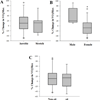APOEε4 impacts up-regulation of brain-derived neurotrophic factor after a six-month stretch and aerobic exercise intervention in mild cognitively impaired elderly African Americans: A pilot study
- PMID: 27864047
- PMCID: PMC5193139
- DOI: 10.1016/j.exger.2016.11.001
APOEε4 impacts up-regulation of brain-derived neurotrophic factor after a six-month stretch and aerobic exercise intervention in mild cognitively impaired elderly African Americans: A pilot study
Abstract
Possession of the Apolipoprotein E (APOE) gene ε4 allele is the most prevalent genetic risk factor for late onset Alzheimer's disease (AD). Recent evidence suggests that APOE genotype differentially affects the expression of brain-derived neurotrophic factor (BDNF). Notably, aerobic exercise-induced upregulation of BDNF is well documented; and exercise has been shown to improve cognitive function. As BDNF is known for its role in neuroplasticity and survival, its upregulation is a proposed mechanism for the neuroprotective effects of physical exercise. In this pilot study designed to analyze exercise-induced BDNF upregulation in an understudied population, we examined the effects of APOEε4 (ε4) carrier status on changes in BDNF expression after a standardized exercise program. African Americans, age 55years and older, diagnosed with mild cognitive impairment participated in a six-month, supervised program of either stretch (control treatment) or aerobic (experimental treatment) exercise. An exercise-induced increase in VO2Max was detected only in male participants. BDNF levels in serum were measured using ELISA. Age, screening MMSE scores and baseline measures of BMI, VO2Max, and BDNF did not differ between ε4 carriers and non-ε4 carriers. A significant association between ε4 status and serum BDNF levels was detected. Non-ε4 carriers showed a significant increase in BDNF levels at the 6month time point while ε4 carriers did not. We believe we have identified a relationship between the ε4 allele and BDNF response to physiologic adaptation which likely impacts the extent of neuroprotective benefit gained from engagement in physical exercise. Replication of our results with inclusion of diverse racial cohorts, and a no-exercise control group will be necessary to determine the scope of this association in the general population.
Keywords: APOE; Aerobic exercise; African Americans; BDNF; Mild cognitive impairment; Oxygen consumption.
Copyright © 2016 The Authors. Published by Elsevier Inc. All rights reserved.
Figures


Similar articles
-
Associations Between ApoEε4 Carrier Status and Serum BDNF Levels--New Insights into the Molecular Mechanism of ApoEε4 Actions in Alzheimer's Disease.Mol Neurobiol. 2015;51(3):1271-7. doi: 10.1007/s12035-014-8804-8. Epub 2014 Jul 2. Mol Neurobiol. 2015. PMID: 24986007
-
Exercise Training Induced Changes In Nuclear Magnetic Resonance-Measured Lipid Particles In Mild Cognitively Impaired Elderly African American Volunteers: A Pilot Study.Clin Interv Aging. 2019 Dec 5;14:2115-2123. doi: 10.2147/CIA.S195878. eCollection 2019. Clin Interv Aging. 2019. PMID: 31824142 Free PMC article. Clinical Trial.
-
APOE ε4 and the risk for Alzheimer disease and cognitive decline in African Americans and Yoruba.Int Psychogeriatr. 2014 Jun;26(6):977-85. doi: 10.1017/S1041610214000167. Epub 2014 Feb 24. Int Psychogeriatr. 2014. PMID: 24565289 Free PMC article.
-
The effect of the APOE4 genotype on physiological and cognitive health in randomised controlled trials with an exercise intervention: a systematic review and meta-analysis.Trials. 2025 Jan 20;26(1):20. doi: 10.1186/s13063-024-08696-4. Trials. 2025. PMID: 39828710 Free PMC article.
-
The Relationship Between Sleep Disturbance and Apolipoprotein E ε4 in Adults With Mild Cognitive Impairment and Alzheimer's Disease Dementia: An Integrative Review.Biol Res Nurs. 2022 Jul;24(3):327-337. doi: 10.1177/10998004221081044. Epub 2022 Apr 19. Biol Res Nurs. 2022. PMID: 35439097 Review.
Cited by
-
Possible Neuroprotective Mechanisms of Physical Exercise in Neurodegeneration.Int J Mol Sci. 2020 Aug 16;21(16):5895. doi: 10.3390/ijms21165895. Int J Mol Sci. 2020. PMID: 32824367 Free PMC article. Review.
-
Blood biomarkers as surrogate endpoints of treatment responses to aerobic exercise and cognitive training (ACT) in amnestic mild cognitive impairment: the blood biomarkers study protocol of a randomized controlled trial (the ACT Trial).Trials. 2020 Jan 6;21(1):19. doi: 10.1186/s13063-019-3798-1. Trials. 2020. PMID: 31907024 Free PMC article.
-
Bacopa monnieri supplementation has no effect on serum brain-derived neurotrophic factor levels but beneficially modulates nuclear factor kappa B and cyclic AMP response element-binding protein levels in healthy elderly subjects.J Clin Transl Res. 2023 Jan 17;9(1):50-58. eCollection 2023 Feb 25. J Clin Transl Res. 2023. PMID: 37032999 Free PMC article.
-
Effects of physical activities on dementia-related biomarkers: A systematic review of randomized controlled trials.Alzheimers Dement (N Y). 2021 Jan 20;6(1):e12109. doi: 10.1002/trc2.12109. eCollection 2020. Alzheimers Dement (N Y). 2021. PMID: 33521235 Free PMC article. Review.
-
Multi-omics studies reveal ameliorating effects of physical exercise on neurodegenerative diseases.Front Aging Neurosci. 2022 Oct 31;14:1026688. doi: 10.3389/fnagi.2022.1026688. eCollection 2022. Front Aging Neurosci. 2022. PMID: 36389059 Free PMC article. Review.
References
-
- Gurland BJ, Wilder DE, Lantigua R, Stern Y, Chen J, Killeffer EH, Mayeux R. Rates of dementia in three ethnoracial groups. Int J Geriatr Psychiatry. 1999;14:481–493. - PubMed
-
- Nussbaum RL. Genome-wide association studies, Alzheimer disease, and understudied populations. JAMA. 2013;309:1527–1528. - PubMed
Publication types
MeSH terms
Substances
Grants and funding
LinkOut - more resources
Full Text Sources
Other Literature Sources
Medical
Research Materials
Miscellaneous

